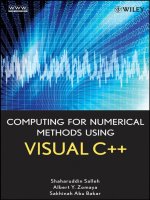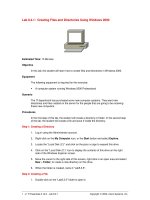Forex Trading Using Intermarket Analysis_1 docx
Bạn đang xem bản rút gọn của tài liệu. Xem và tải ngay bản đầy đủ của tài liệu tại đây (206.84 KB, 14 trang )
Louis B. MendeLsohn
Foreword By darreLL r. JoBMan
TRADE SECRETS
Discovering HiDDen Market relationsHips
tHat proviDe early clues for price Direction
Forex Trading
Intermarket
analysIs
usIng
FOREX
TRADING USING
INTERMARKET
ANALYSIS
FOREX
TRADING USING
INTERMARKET
ANALYSIS
discovering hidden
Market reLationships
that provide earLy
cLues For price
direction
Louis B. MendeLsohn
Foreword By darreLL r. JoBMan
MarketpLace Books
®
coLuMBia, MaryLand
Trade
Trade
Copyright © 2006 by Market Technologies, LLC. All rights reserved. Reproduction
or translation of any part of this work beyond that permitted by Section 107 or
108 of the 1976 United States Copyright Act without the permission of the copy-
right owner is unlawful. Requests for permission or further information should be
addressed to the Permissions Department at Marketplace Books
®
.
VantagePoint Intermarket Analysis Software is a trademark of Market Technologies,
LLC. Synergistic Market Analysis and Hurricaneomic Analysis are service marks
of Louis B. Mendelsohn. All other trademarks, service marks, or registered
trademarks are the property of their respective owners. Other names, designs,
titles, words, logos, or phrases in this publication may constitute trademarks,
service marks, or trade names of other entities that may be registered in certain
jurisdictions.
This publication is designed to provide accurate and authoritative information
and the views and opinions of the author in regard to the subject matter covered.
It is sold with the understanding that neither the publisher, copyright holder,
nor the author is engaged in (1) providing commodity trading advice based on,
or tailored to, the commodity interests or cash market positions or other circum-
stances or characteristics of any particular client, or (2) rendering investment,
legal, accounting, or other professional services. If trading or investment advice or
other expert assistance is required, the services of a competent and appropriately
licensed person should be sought.
From a Declaration of Principles jointly adopted by a Committee of the American
Bar Association and a Committee of Publishers.
This book, along with other books, is available at discounts
that make it realistic to provide them as gifts to your custom-
ers, clients, and staff. For more information on these long last-
ing, cost effective premiums, please call us at 800-272-2855
or e-mail us at
ISBN 1-59280-295-8
Printed in the United States of America.
1 2 3 4 5 6 7 8 9 10
CONTENTS
FOREWORD IX
PREFACE XV
INTRODUCTION XIX
Chapter 1
WHAT IS FOREX? 1
If you have traveled internationally, you may already know some-
thing about the forex market, today’s hottest marketplace. Discover
why you might want to trade forex.
Chapter 2
THE FOREX MARKETPLACE 11
The forex market is the world’s largest marketplace, dwarfing all
other markets combined. See how forex grew so large and how you
can participate.
Chapter 3
FUNDAMENTALS AND FOREX 21
Forex traders can get plenty of information, sometimes so much that
it can be hard to sift through it all. Here are some reports a forex
trader needs to consider.
Chapter 4
APPLYING TECHNICAL ANALYSIS TO FOREX 35
With fundamental information overwhelming, many forex traders
analyze price action in charts. Chart patterns and indicators have
shortcomings, but see how predictive moving averages can help with
market forecasting.
vii
trade secrets
viii
Chapter 5
INTERMARKET ANALYSIS OF FOREX MARKETS 49
What happens in one market is influenced by what happens in a
number of related markets. Discover why single-market analysis
should give way to intermarket analysis in today’s global market-
place, especially in forex markets, which are ideally suited for this
type of analysis.
Chapter 6
USING NEURAL NETWORKS TO ANALYZE FOREX 63
With so many fundamentals and so much influence from related mar-
kets, it’s hard to see all the patterns and relationships in the forex
market. Find out how neural networks can uncover hidden patterns
in data and select the best to make short-term market forecasts.
Chapter 7
TECHNICAL TACTICS FOR TRADING FOREX 71
Once you understand how the forex market works and the basics of
technical analysis, you are ready to put theory into practice. Here
are a few more practical tips and chart examples to help you apply
your knowledge to actual trading.
Chapter 8
WAVE OF THE FUTURE: SYNERGISTIC MARKET ANALYSIS 87
Using only one approach to trade no longer works in today’s global
markets. Successful trading requires the synthesis of technical,
intermarket and fundamental approaches.
TRADING RESOURCE GUIDE 93
ABOUT THE AUTHOR AND MARKET TECHNOLOGIES, LLC 105
FOREWORD
FOREWORD
Xi
ForeX trading using interMarket anaLysis
IN THE EARLY 1980s, as the editor-in-chief of Commodities maga-
zine, I was privy to a number of different trading ideas and tech-
niques—so many, in fact, it was difficult to determine which was
best or sometimes which had merit. This was during the heyday of
innovations in the futures markets with the introduction of the cash-
settlement concept in eurodollar futures, futures on broad-based stock
indexes, crude oil futures, the pilot program for options on futures, and
a number of other new contracts in areas where futures and options
did not exist before. It also was the period when the personal computer
was introduced and trading software was a new market analysis tool.
Inevitably, the developments in futures trading and in computerized
market analysis using trading software began to come together, and it
became obvious that the magazine needed to devote a lot more space
to this subject. The problem was finding authors with actual trading
experience who could explain the value of using this new computer
technology for market analysis to readers without an academic back-
ground in computer science.
In early 1983 I received an article from Lou Mendelsohn. Lou and
I did not know each other. He had a message about trading software
that he was willing to share, and he knew that Commodities was the
best way to reach a broad audience of futures traders. I just happened
to be looking for good articles on that subject. What Lou submitted
contained solid information on this new technology, and as a bonus,
his article was well written. No one on the magazine’s staff could have
written such an article at that point because no one had the trading
experience nor the knowledge of computers and trading software that
Lou provided.
His first article entitled, “Picking Software Programs: Know Their
Limitations,” appeared in the May 1983 issue of Commodities. This
article compared analysis software and system software in a logical,
trade secrets
Xii
sensible way. At that time Lou recommended at least a 48-kilobyte
computer—not the megabytes or gigabytes that are common today—
evidence that this was a time when many traders were just learning
how to use personal computers.
A second article, entitled “History Tester Important Factor in Software
Selection,” appeared in the July 1983 issue of Commodities. Lou
emphasized the need for a history tester to compare the performance
of different trading strategies and to have standardized performance
reports so traders could make accurate comparisons of the results.
Today we know about net return per trade, drawdowns, and all the
other aspects of performance provided by software programs, but Lou’s
implementation of strategy back-testing in software for the personal
computer was the first in the financial industry, long before TradeStation
and other competing software programs appeared on the scene.
A third article, entitled “Execution Timing Critical Factor in System
Performance,” appeared in December 1983. By then, Commodities
was called Futures as the move toward financial products had begun.
In this article Lou analyzed the results of various entry and exit
points in Treasury bill futures, one of the first articles featuring this
type of research.
All of these articles illustrated Lou’s thorough understanding of
the markets and how traders could use their personal computers to
analyze data and develop successful trading systems and strategies.
This was new information to traders, and Lou’s pioneering work was
instrumental in incorporating the personal computer into the trading
mainstream, particularly with the release in 1983 of his ProfitTaker
software program. This was the first trading software program avail-
able for personal computers that performed strategy back-testing.
ProfitTaker laid the foundation for much of the technical analysis soft-
ware development that has evolved over the past twenty-five years.
Xiii
ForeX trading using interMarket anaLysis
Lou has continued to write extensively on the application of com-
puter and software technologies to trading and has pursued various
areas of research for the benefit of traders performing market analysis
with their computers. Intuitively, traders know that a target market is
influenced by developments in related markets and, in turn, the target
market affects what happens in other markets. The difficulty is in
quantifying those relationships. In the late 1980s Lou discovered that,
by applying computerized “artificial intelligence” concepts, involving
a mathematical technology known as neural networks, to market analy-
sis he could ferret out intermarket patterns and connections between
markets that could never be seen through chart analysis. He then used
that information to forecast moving averages, making them a leading
rather than a lagging technical indicator.
His research into intermarket relationships and predicted moving
averages led to the development of VantagePoint Intermarket Analysis
Software
™
, first released in 1991. The research has not ended there,
however, as newly updated versions are released, all of which benefit
from his ongoing research into the application of neural networks to
intermarket analysis and incorporate new “learning” by the software
through periodic retraining of the neural networks.
This book is a result of Lou’s ongoing research, focusing specifically on
the foreign exchange market, the largest trading market in the world. If
there is a market that is perfectly matched to Lou’s analytical approach
of applying computerized trading software technology, such as neural
networks, to intermarket analysis, it is the forex market because of the
relationships of various currencies to each other and to other financial
influences (i.e., interest rates, stock indexes in a global marketplace).
As icing on the cake, forex is typically a trending market that makes it
an excellent candidate for his forecasted moving average analysis.









